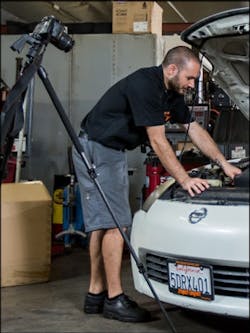When Bryan Friday and his brother opened Project Import Performance & Automotive Repair 12 years ago, the local auto care competition was stiff. And with just two technicians in the shop and annual revenue around $300,000, Friday soon realized his business would have to differentiate itself to stay afloat.
“All the shops are so close together—it’s a flooded market here,” he says. “It’s a little harder to just get customers in the old-fashioned way. We have to attack every avenue possible in California.”
On a personal level, Friday says the ability to help others makes his job worth having. Performing an average of 50 repairs per month at his Orange, Calif., business, he decided the first step to the shop’s differentiation was to make the few customer-to-shop interactions he experienced each day more personal by recording videos of the repairs.
The second step involved the 15-year veteran’s love of and history with repairing cars: making and selling auto parts. Friday grew up fixing cars and building his own parts, and adding a parts store in addition to his shop made sense when starting up.
The problem? Parts sales weren’t very high, and the Friday’s innovations weren’t reaching very many customers.
So, six years ago, he had an idea, something he knew none of his local competition was doing. He was going to transfer the unique trust earned from those personal interactions and his ambition of creating auto parts for auto repair enthusiasts through a little website you may have heard of, one that just happens to have more than 1 billion users: YouTube.
STARTING A CHANNEL
Auto repair channels on YouTube are nothing new. “EricTheCarGuy” has over 650,000 followers; “robinsonauto” posts several videos per month detailing different repairs; “South Main Auto Repair” receives hundreds of comments from technicians from all over world asking for advice on various jobs.
Setting up a channel is easy: You simply set up a Google account (if you don’t already have one), choose “Create a New Channel” (youtube.com/channel_switcher), and then identify yourself as a “company” on the site when choosing a channel title.
Simply establishing a landing page wasn’t the tough part—now Friday had to learn how to produce engaging, well-produced videos.
It was rough at first, Friday admits. When he uploaded his first video on April 22, 2009, the quality was very poor and there was little commentary.
Yet, even with that first attempt, the videos have fulfilled their one goal: display the parts in action. From revving up a DOHC ZC engine to checking the compression on a 2007 Mazda to performing water pump and timing belt inspections on an Audi A6, Friday realized the “hard sell” wouldn’t sell people on his parts. He simply needed to show—not tell—his audience that the purchase was worth it.
“What appeals to them about the videos is it’s more tangible,” he says. “You get to see a tech working on a vehicle versus just looking at pictures. It’s more personal and engaging that way.”
While the videos were low quality at first (he was using a cheap camera that was lying around the house), the views slowly started trickling in. During that first year, he produced around 100 videos. And while some failed to break 1,000 views, others were getting thousands, even tens of thousands of views.
As the shop’s sales and subscriber base started building, he invested in better equipment. He spent a few thousand dollars on a Canon EOS Rebel T5 DSLR Camera and a new MacBook Pro that came with editing software. Then he made the videos slicker by adding an intro and outro title.
NOT-SO-VIRAL MARKETING
Project Import’s YouTube channel proves that “going viral” isn’t everything. Over the course of six years, Friday has produced about 250 videos that have racked up millions of views. The videos are often only a couple minutes in length. Sometimes he’ll go weeks, sometimes months between uploading content that highlights the shop’s latest creation. In total, the channel has just over 3,000 subscribers. Most videos get a few thousand views, and some have even topped 100,000 in the past.
Project Import Performance & Automotive Repair
location: Orange, Calif.
Size: 7,200 square feet
Staff: 6 (2 owners, 2 technicians, 1 parts salesman, 1 assistant)
Annual Revenue: $800,000
Average monthly car count: 50
And while 100,000 views is nothing to a celebrity, 18,000 views on one particular recent video equated to thousands in revenue for Friday’s shop.
Friday saw an opportunity with a VQ35 motors’ PCV system, which tends to suck oil into intake manifolds and leak into the combustion chamber, causing fuel dilution and compression issues.
To solve the problem, Friday introduced the PI 350Z/G35 VQ35DE and REVUP Complete Crank Case Breather Kit. It replaces the PCV valve and prevents oil from leaking into the combustion chamber. Friday filmed a short video of the system, uploaded it to YouTube and linked it directly to his shop’s site.
With Friday and his brother performing all of the shooting and editing themselves, the Project Import team has slowly perfected the art of the soft sell. For most videos, Friday highlights in-house jobs step-by-step, not only providing great auto care tips for fellow technicians, but also often subtly highlighting products his shop is attempting to sell.
“The idea of promoting your shop through YouTube was new back in 2009,” Friday says. “It wasn’t as prevalent. And we just saw the ability to possibly market ourselves and our product to our customers. It wasn’t an ad—this is work we do everyday. Most of our videos are showing our installations, our completed work, problems we’ve found and solved.”
With 130 sold and counting, the Crank Case Breather Kit’s success is just a small part of Project Import’s growth since the YouTube channel’s conception. The return on investment has been massive for Friday—spending just a couple thousand dollars on the new camera and MacBook Pro, Friday has seen his online sales numbers skyrocket over the past six years. Without increasing his staff size or advertising budget, Friday has managed to up the shop’s annual revenue to over $800,000, which he can now invest directly into growing the shop.
SPREADING YOUR REACH
While YouTube reaches over 1 billion users, some shop owners use the website to promote themselves locally.
One of them is Rick Bettger—owner of House of Mufflers & Brakes in Omaha, Neb.—who uses YouTube to produce his videos, which are then sent out to a database of 8,000 emails he’s collected over the years.
Usually, the videos contain car care tips, spiced up with Bettger’s zany personality. He’s covered everything from the danger of relying on your engine oil light to mocking local political candidates during election coverage. Regardless of the subject matter, Bettger is always sure to include a coupon with the video.
While it’s hard to determine how much income the videos rake in, Bettger is sure it’s been worth the investment. He pays a company called Vyral Marketing $295 per month to maintain the shop’s customer database and promote the videos.
One thing Bettger can track is the open-rate on the emails. At least 20 percent—1,600 customers—open the email, and 7 percent actually click through the content.
“$295 is nothing. That's one ticket,” Bettger says. “You know the business: It's about how many times you can touch a customer. You try and remain top of mind with whatever you can. It gives us the complete edge on anybody here in Omaha. Nobody does the kind of stuff we're doing on a social media basis. We're definitely trying to reach a different demographic than what we have. We're trying to dig into Generation X and Y. That's what we've done.”
MADE LOCAL, SOLD GLOBAL
While Friday looks back at his early, amateur attempts at creating videos with slight embarrassment, the goal has always remained steady and worked consistently: advertise the shop-made parts, reach a global audience for online sales, and solidify your reputation locally by promoting the videos through other forms of social media, like Twitter and Facebook.
Locally, it’s much harder to tangibly gauge the YouTube channel’s success. However, since launching the videos, he said many customers have found his shop through his videos.
“In our industry, there’s a lot of distrust among customers,” he says. “Our ability to show we fixed it and what we do, that makes us different. We’ve had great feedback from it: ‘Wow, I had that same problem and nobody was able to show me that. When can I come in and bring my car in? Can you fix this for me?’ Plus, they trust our parts.”
“It’s a trust factor. I think it helps with the transparency of the repairs. People see that we’re a legitimate shop. They see that we built the parts and we’re putting them on cars, that we’re working on them every day. I think that it helps people ease their minds a bit.”
The best part is that Friday isn’t satisfied with the channel’s monetary success. He wants to be bigger and better, which means contracting a professional to film an intro for his videos, hiring a full-time social media assistant to promote them, and forming an actual budget for his online endeavors. In the past few months, he added a new animated introduction that displays the shop’s logo.
“We want it to seem more professional,” he says. “It’s our best marketing tool, and, over time, it’s made our shop better.”
Connecting Technicians
As the sole tech/owner for his shop, South Main Auto Repair, located in the small town of Avoca, N.Y., Eric Obrochta was desperately seeking some feedback, some communication from other technicians on doing jobs more efficiently.
Much like Friday, Obrochta found his answers on YouTube. And today, with a loyal subscriber base that nearly quadruples the entire population of Avoca, he’s got more than his fair share of technicians from all over the world commenting on his videos.
Obrochta simply films repairs that come through his shop. He details the process, highlights tips and tricks he uses to be more efficient, and then asks for feedback from his band of followers.
“I'm a pretty good visual learner,” Obrochta says. “I like good, clean explanations. I like to be able to see what's going on. I just applied what I'd like to see and learn about to my videos.”
In the eight months he’s run the channel, he’s produced over 150 vehicles and grown a subscriber base of 10,000. Some videos producing thousands of comments, and Obrochta is in constant contact with fellow technicians throughout the country looking to gain insight and knowledge for performing better repairs.
“We can get into a host of conversations, whether it's just repairs, how-tos, or shop management,” he says. ‘If you choose to respond to these people, they seem more willing to talk and have conversation. It’s really exploded and it's been a ton of fun. It's almost overwhelming sometimes. There's so many people I know now and interact with.”

